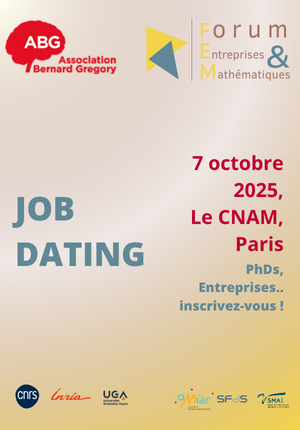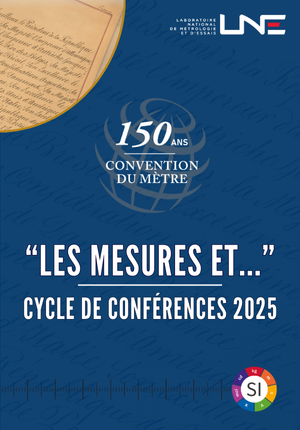Excitations et déformations aux interfaces twistées de nitrure de bore hexagonal // Excitations and deformations at the twisted interfaces of hexagonal boron nitride
|
ABG-132016
ADUM-66090 |
Thesis topic | |
| 2025-05-16 |
Université Paris-Saclay GS Physique
Châtillon cedex - Ile-de-France - France
Excitations et déformations aux interfaces twistées de nitrure de bore hexagonal // Excitations and deformations at the twisted interfaces of hexagonal boron nitride
- Physics
moiré, simulations, matériaux 2D, twistronique
moiré, simulations, 2D materials, twistronique
moiré, simulations, 2D materials, twistronique
Topic description
Le contrôle à l'échelle nanométrique de la composition et de la morphologie des matériaux a permis l'émergence de nouvelles propriétés structurales, électroniques et chimiques, qui sont à la base de nombreux progrès technologiques récents. Dans ce contexte, les matériaux 2D, c'est à dire des matériaux formés par des empilements de couches atomiques, constituent une catégorie dont l'impact technologique actuel et potentiel est avéré. Ceci est dû, entre autres, à l'exceptionnelle variabilité de leurs propriétés. Par exemple, en 2018 il a été démontré que le simple fait de désaligner deux couches de graphène fait surgir un état supraconducteur [1]. Cette observation a donné naissance à la twistronique, une branche d'études portant sur l'émergence et le contrôle de propriétés liées au désalignement (twist) et aux motifs de moiré qui en résultent.
Le LEM a su se positionner sur ce sujet à travers des travaux à la fois théoriques [2,3] et expérimentaux [4,5] portant sur les excitons aux interfaces twistées de nitrure de bore hexagonal, un matériau sur lequel le laboratoire a développé une expertise décennale. Ce projet de thèse s'inscrit donc dans le sillage de ces travaux et il a comme objectif d'améliorer les modèles que nous utilisons pour décrire la physique excitonique aux interfaces twistées. Plus précisément, des mesures de luminescence [4,5,6] montrent qu'un complexe phénomène de piégeage/dépiégeage d'excitons a lieux à l'interface twistée entre deux blocs de BN, et que l'équilibre entre ces deux mécanismes dépend de l'angle.
Dans les deux articles théoriques mentionnés au-par-avant [2,3], plusieurs éléments sont fournis vers la compréhension de ces observations et des étapes ont été franchies en ce sens, mais des défis restent à relever.
1) Le premier défi consiste à dépasser l'approximation de bicouche isolée pour s'approcher davantage aux échantillons expérimentaux. Ceci requiert de prendre en compte les interactions entre les atomes à l'interface et ceux qui constituent le reste (semi-infini) du cristal. Cet objectif sera atteint, notamment, en tirant profit de la complémentarité entres approches liaisons fortes et simulations ab initio, une stratégie que, par le passé, nous avons déjà appliquée avec succès [3, 7–10].
2) Le deuxième effet à prendre en compte sera la relaxation structurale qui a lieu à l'interface avant même que l'exciton soit formé. Un deuxième objectif de la thèse sera donc d'inclure ce phénomène dans les simulations liaisons fortes à l'aide de calculs de dynamique moléculaire et d'en étudier les effets sur les propriétés électroniques associées à l'état fondamental (densité de charge, structure de bandes, spectres à particules indépendantes).
3) Le dernier objectif sera la description explicite des mécanismes de piégeage et dépiégeage de l'exciton d'interface. Pour ce faire, il sera nécessaire de disposer de la distribution de charges associée à l'état excité et de calculer les déformations que celle-ci induit sur le réseau de l'interface et des couches voisines. Pour ce faire, il sera indispensable de s'appuyer sur les autres accomplissements de la thèse ainsi que sur le modèle excitonique liaisons fortes actuellement développé en interne en collaboration avec le CEA et le ICN2 (Barcelone).
------------------------------------------------------------------------------------------------------------------------------------------------------------------------
------------------------------------------------------------------------------------------------------------------------------------------------------------------------
The nanometric control of material composition and morphology has permitted the emergence of novel structural, electronic and chemical properties which are at the foundations of many recent technological advances. In this respect, 2D materials, i.e. materials formed par stacks of atomic layers, constitute a class of materials with recognized technological impact. Among other reasons, this is due to the exceptional diversity and tunability of their properties. For instance, in 2018, it has been demonstrate that the simple fact of twisting one layer of graphene on top of another endows the bilayer with supraconducting properties [1]. This observation set the stage for the twistronics, a research branch focusing on the investigation and the control of the properties induced by twisting stacks of 2D materials and the moiré patterns that are thus formed.
The LEM occupies a leading position in this subject thanks to several theoretical [2,3] and experimental works [4,5] about excitons at the twisted interfaces of hexagonal boron nitride (hBN), a material on which the laboratory has built a recognized expertise over the years. This Ph.D. project stems from these works and extends them with the objective of improving over the models that we are currently using to describe excitonic physics at twisted interfaces. More precisely, luminescence measurements [4,5,6] show that a complex angle-dependent balance of exciton trapping and detrapping takes place at the twisted interface of two BN thick crystals.
In the two theoretical articles mentioned above [2,3], some insight has been given to understand these observations, but other questions are still unanswered and challenges have to be tackled.
1) The first objective is to go beyond the approximation of isolated bilayers and get closer to the experimental samples. This implies accounting for the interactions between the atoms of the interface and those composing the rest of the (semi-infinite) crystal. This task will be accomplished by taking advantage of the complementarity between tight-binding approaches and ab initio simulations. In the past, we have applied this strategy with success in similar problems [3, 7–10].
2) The second effect to include is the structural relaxation occurring at the interface before the formation of the exciton, i.e. at the ground state level. So, a second objective of the Ph.D. will be that of implementing this mechanism in tight-binding simulations through molecular dynamics. The candidate will then study the effects of the structural relaxation on the electronic properties of the ground state (charge density, band structure, independent-particle spectra).
3) The last objective will aim at the explicit description of the exciton trapping and detrapping mechanisms. To this aim, it will be necessary to know the charge distribution of the excited state and calculate the structural deformations that the latter induces on the interface lattice. To attain this goal, it will be crucial to take advantage of the other advances of the project and of the tight-binding excitonic model currently developed at the LEM in collaboration with CEA and ICN2 (Barcelona).
------------------------------------------------------------------------------------------------------------------------------------------------------------------------
------------------------------------------------------------------------------------------------------------------------------------------------------------------------
Début de la thèse : 01/10/2025
Le LEM a su se positionner sur ce sujet à travers des travaux à la fois théoriques [2,3] et expérimentaux [4,5] portant sur les excitons aux interfaces twistées de nitrure de bore hexagonal, un matériau sur lequel le laboratoire a développé une expertise décennale. Ce projet de thèse s'inscrit donc dans le sillage de ces travaux et il a comme objectif d'améliorer les modèles que nous utilisons pour décrire la physique excitonique aux interfaces twistées. Plus précisément, des mesures de luminescence [4,5,6] montrent qu'un complexe phénomène de piégeage/dépiégeage d'excitons a lieux à l'interface twistée entre deux blocs de BN, et que l'équilibre entre ces deux mécanismes dépend de l'angle.
Dans les deux articles théoriques mentionnés au-par-avant [2,3], plusieurs éléments sont fournis vers la compréhension de ces observations et des étapes ont été franchies en ce sens, mais des défis restent à relever.
1) Le premier défi consiste à dépasser l'approximation de bicouche isolée pour s'approcher davantage aux échantillons expérimentaux. Ceci requiert de prendre en compte les interactions entre les atomes à l'interface et ceux qui constituent le reste (semi-infini) du cristal. Cet objectif sera atteint, notamment, en tirant profit de la complémentarité entres approches liaisons fortes et simulations ab initio, une stratégie que, par le passé, nous avons déjà appliquée avec succès [3, 7–10].
2) Le deuxième effet à prendre en compte sera la relaxation structurale qui a lieu à l'interface avant même que l'exciton soit formé. Un deuxième objectif de la thèse sera donc d'inclure ce phénomène dans les simulations liaisons fortes à l'aide de calculs de dynamique moléculaire et d'en étudier les effets sur les propriétés électroniques associées à l'état fondamental (densité de charge, structure de bandes, spectres à particules indépendantes).
3) Le dernier objectif sera la description explicite des mécanismes de piégeage et dépiégeage de l'exciton d'interface. Pour ce faire, il sera nécessaire de disposer de la distribution de charges associée à l'état excité et de calculer les déformations que celle-ci induit sur le réseau de l'interface et des couches voisines. Pour ce faire, il sera indispensable de s'appuyer sur les autres accomplissements de la thèse ainsi que sur le modèle excitonique liaisons fortes actuellement développé en interne en collaboration avec le CEA et le ICN2 (Barcelone).
------------------------------------------------------------------------------------------------------------------------------------------------------------------------
------------------------------------------------------------------------------------------------------------------------------------------------------------------------
The nanometric control of material composition and morphology has permitted the emergence of novel structural, electronic and chemical properties which are at the foundations of many recent technological advances. In this respect, 2D materials, i.e. materials formed par stacks of atomic layers, constitute a class of materials with recognized technological impact. Among other reasons, this is due to the exceptional diversity and tunability of their properties. For instance, in 2018, it has been demonstrate that the simple fact of twisting one layer of graphene on top of another endows the bilayer with supraconducting properties [1]. This observation set the stage for the twistronics, a research branch focusing on the investigation and the control of the properties induced by twisting stacks of 2D materials and the moiré patterns that are thus formed.
The LEM occupies a leading position in this subject thanks to several theoretical [2,3] and experimental works [4,5] about excitons at the twisted interfaces of hexagonal boron nitride (hBN), a material on which the laboratory has built a recognized expertise over the years. This Ph.D. project stems from these works and extends them with the objective of improving over the models that we are currently using to describe excitonic physics at twisted interfaces. More precisely, luminescence measurements [4,5,6] show that a complex angle-dependent balance of exciton trapping and detrapping takes place at the twisted interface of two BN thick crystals.
In the two theoretical articles mentioned above [2,3], some insight has been given to understand these observations, but other questions are still unanswered and challenges have to be tackled.
1) The first objective is to go beyond the approximation of isolated bilayers and get closer to the experimental samples. This implies accounting for the interactions between the atoms of the interface and those composing the rest of the (semi-infinite) crystal. This task will be accomplished by taking advantage of the complementarity between tight-binding approaches and ab initio simulations. In the past, we have applied this strategy with success in similar problems [3, 7–10].
2) The second effect to include is the structural relaxation occurring at the interface before the formation of the exciton, i.e. at the ground state level. So, a second objective of the Ph.D. will be that of implementing this mechanism in tight-binding simulations through molecular dynamics. The candidate will then study the effects of the structural relaxation on the electronic properties of the ground state (charge density, band structure, independent-particle spectra).
3) The last objective will aim at the explicit description of the exciton trapping and detrapping mechanisms. To this aim, it will be necessary to know the charge distribution of the excited state and calculate the structural deformations that the latter induces on the interface lattice. To attain this goal, it will be crucial to take advantage of the other advances of the project and of the tight-binding excitonic model currently developed at the LEM in collaboration with CEA and ICN2 (Barcelona).
------------------------------------------------------------------------------------------------------------------------------------------------------------------------
------------------------------------------------------------------------------------------------------------------------------------------------------------------------
Début de la thèse : 01/10/2025
Funding category
Funding further details
Financement de l'ONERA
Presentation of host institution and host laboratory
Université Paris-Saclay GS Physique
Institution awarding doctoral degree
Université Paris-Saclay GS Physique
Graduate school
572 Ondes et Matière
Candidate's profile
Master en physique ou science des matériaux / Ecole d'ingénieur
Connaissances solides en mécanique quantique et physique de la matière condensée
Goût prononcé pour la simulation numérique
M2 in physics or materials science or engineering Good knowledge on quantum mechanics and condensed matter physics Keen interest in numerical simulations
M2 in physics or materials science or engineering Good knowledge on quantum mechanics and condensed matter physics Keen interest in numerical simulations
2025-09-30
Apply
Close
Vous avez déjà un compte ?
Nouvel utilisateur ?
More information about ABG?
Get ABG’s monthly newsletters including news, job offers, grants & fellowships and a selection of relevant events…
Discover our members
 TotalEnergies
TotalEnergies  Laboratoire National de Métrologie et d'Essais - LNE
Laboratoire National de Métrologie et d'Essais - LNE  MabDesign
MabDesign  CASDEN
CASDEN  ASNR - Autorité de sûreté nucléaire et de radioprotection - Siège
ASNR - Autorité de sûreté nucléaire et de radioprotection - Siège  Généthon
Généthon  ONERA - The French Aerospace Lab
ONERA - The French Aerospace Lab  CESI
CESI  SUEZ
SUEZ  Aérocentre, Pôle d'excellence régional
Aérocentre, Pôle d'excellence régional  Institut Sup'biotech de Paris
Institut Sup'biotech de Paris 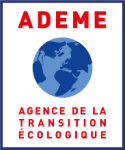 ADEME
ADEME  MabDesign
MabDesign 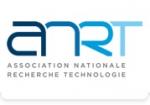 ANRT
ANRT 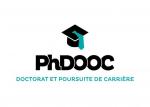 PhDOOC
PhDOOC  Tecknowmetrix
Tecknowmetrix  Ifremer
Ifremer  Groupe AFNOR - Association française de normalisation
Groupe AFNOR - Association française de normalisation  Nokia Bell Labs France
Nokia Bell Labs France
-
JobRef. 132634Strasbourg , Grand Est , FranceINSERM UMR 1260
Post-doctoral opportunity in Strasbourg (France): Complex Organoids for IBD Immunotherapy
Scientific expertises :Biology - Health, human and veterinary medicine
Experience level :Confirmed
-
Thesis topicRef. 131449Sophia-Antipolis , Ile-de-France , France
 Mines Paris - PSL, Centre PERSEE & RTE
Mines Paris - PSL, Centre PERSEE & RTEPhD CIFRE RTE - MINES PARIS: Artificial Intelligence for Renewable Energy Forecasting
Scientific expertises :Engineering sciences - Energy - Mathematics

